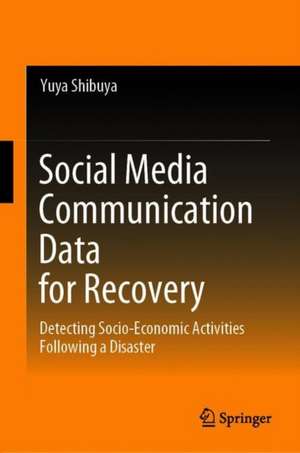Social Media Communication Data for Recovery: Detecting Socio-Economic Activities Following a Disaster
Autor Yuya Shibuyaen Limba Engleză Hardback – 2 dec 2019
This book explores the possibility of using social media data for detecting socio-economic recovery activities. In the last decade, there have been intensive research activities focusing on social media during and after disasters. This approach, which views people’s communication on social media as a sensor for real-time situations, has been widely adopted as the “people as sensor” approach. Furthermore, to improve recovery efforts after large-scale disasters, detecting communities’ real-time recovery situations is essential, since conventional socio-economic recovery indicators, such as governmental statistics, are not published in real time. Thanks to its timeliness, using social media data can fill the gap.
Motivated by this possibility, this book especially focuses on the relationships between people’s communication on Twitter and Facebook pages, and socio-economic recovery activities as reflected in the used-carmarket data and the housing market data in the case of two major disasters: the Great East Japan Earthquake and Tsunami of 2011 and Hurricane Sandy in 2012. The book pursues an interdisciplinary approach, combining e.g. disaster recovery studies, crisis informatics, and economics.
In terms of its contributions, firstly, the book sheds light on the “people as sensors” approach for detecting socio-economic recovery activities, which has not been thoroughly studied to date but has the potential to improve situation awareness during the recovery phase. Secondly, the book proposes new socio-economic recovery indicators: used-car market data and housing market data. Thirdly, in the context of using social media during the recovery phase, the results demonstrate the importance of distinguishing between social media data posted both by people who are at or near disaster-stricken areas and by those who are farther away.
| Toate formatele și edițiile | Preț | Express |
|---|---|---|
| Paperback (1) | 813.60 lei 6-8 săpt. | |
| Springer Nature Singapore – 2 dec 2020 | 813.60 lei 6-8 săpt. | |
| Hardback (1) | 819.85 lei 6-8 săpt. | |
| Springer Nature Singapore – 2 dec 2019 | 819.85 lei 6-8 săpt. |
Preț: 819.85 lei
Preț vechi: 1024.81 lei
-20% Nou
Puncte Express: 1230
Preț estimativ în valută:
156.87€ • 164.23$ • 129.81£
156.87€ • 164.23$ • 129.81£
Carte tipărită la comandă
Livrare economică 05-19 aprilie
Preluare comenzi: 021 569.72.76
Specificații
ISBN-13: 9789811508240
ISBN-10: 9811508240
Pagini: 228
Ilustrații: XIII, 228 p. 56 illus., 28 illus. in color.
Dimensiuni: 155 x 235 mm
Greutate: 0.52 kg
Ediția:1st ed. 2020
Editura: Springer Nature Singapore
Colecția Springer
Locul publicării:Singapore, Singapore
ISBN-10: 9811508240
Pagini: 228
Ilustrații: XIII, 228 p. 56 illus., 28 illus. in color.
Dimensiuni: 155 x 235 mm
Greutate: 0.52 kg
Ediția:1st ed. 2020
Editura: Springer Nature Singapore
Colecția Springer
Locul publicării:Singapore, Singapore
Cuprins
Declaration of Authorship.- Abstract.- Acknowledgements.- Introduction and Framework
Introduction.- Concept of “People as Sensors”.- Methodology.- Empirical Studies of Socio-Economic Activities After the Great East Japan Earthquake and Tsunami .- The Excess Demand for Used Cars The Excess Demand for Housing.- People As Sensors for Socio-Economic Recovery Activities.- Facebook Page Topics and the Excess Demand for Used Cars.- Data.- Topics on Twitter and the Excess Demand for Used Cars.- Public Sentiment and the Excess Demand for Used Cars.- Social Media Communication and the Excess Demand for Houses.- A Case Study of Hurricane Sandy.- The Excess Demand for Housing after Sandy.- Conclusion
Notă biografică
Yuya Shibuya, Project Assistant Professor, The Graduate School of Interdisciplinary Information Studies, The University of Tokyo, Japan.
Textul de pe ultima copertă
This book explores the possibility of using social media data for detecting socio-economic recovery activities. In the last decade, there have been intensive research activities focusing on social media during and after disasters. This approach, which views people’s communication on social media as a sensor for real-time situations, has been widely adopted as the “people as sensor” approach. Furthermore, to improve recovery efforts after large-scale disasters, detecting communities’ real-time recovery situations is essential, since conventional socio-economic recovery indicators, such as governmental statistics, are not published in real time. Thanks to its timeliness, using social media data can fill the gap.
Motivated by this possibility, this book especially focuses on the relationships between people’s communication on Twitter and Facebook pages, and socio-economic recovery activities as reflected in the used-car market data and the housing market data in the case of two major disasters: the Great East Japan Earthquake and Tsunami of 2011 and Hurricane Sandy in 2012. The book pursues an interdisciplinary approach, combining e.g. disaster recovery studies, crisis informatics, and economics.
In terms of its contributions, firstly, the book sheds light on the “people as sensors” approach for detecting socio-economic recovery activities, which has not been thoroughly studied to date but has the potential to improve situation awareness during the recovery phase. Secondly, the book proposes new socio-economic recovery indicators: used-car market data and housing market data. Thirdly, in the context of using social media during the recovery phase, the results demonstrate the importance of distinguishing between social media data posted both by people who are at or near disaster-stricken areas and by those who are farther away.
Caracteristici
Addresses disaster recovery on the basis of data-driven empirical analysis utilizing social media and market data Presents research based on an interdisciplinary approach combining e.g. disaster recovery studies, crisis informatics, and economics Proposes new socio-economic recovery indicators
